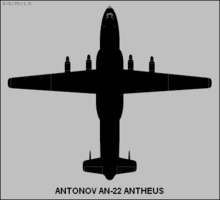Antonov An-22
| Antonov An-22 Antei | |
|---|---|
 An Antonov An-22 in September 2008 |
|
| Type: | Transport plane |
| Design country: | |
| Manufacturer: | |
| First flight: |
February 27, 1965 |
| Commissioning: |
1967 |
| Production time: |
1966 to 1976 |
| Number of pieces: |
68 |
The Antonov An-22 Antei (Russian Антей, Antäus , NATO code name : Cock ) is a transport aircraft with turboprop engines that was developed in the Soviet Union . The machine is the largest mass-produced propeller-driven aircraft .
description
Antonov received the order to develop the An-22 in 1962. The development of the Antonov An-22 began when, in connection with the development of mineral resources, an aircraft was required that could transport large loads over a greater distance. The aircraft has a maximum take-off mass of 250 tons. On its maiden flight on February 27, 1965, the An-22 was the largest production aircraft in the world. To date, the machine is the largest mass-produced aircraft with propeller drive. In the same year the aircraft was presented at the Paris Aviation Salon, with a never-realized passenger version for up to 724 passengers being announced. The aircraft is powered by four Kuznetsov NK-12 turboprop engines, each with two counter-rotating four-blade propellers. The wings of the shoulder wing are equipped with double slotted flaps over the entire span. Similar to the later An-225 Mrija , the An-22 has double rudders that pierce the horizontal stabilizer.
Series production ran from 1965 to February 1976 with 68 machines delivered. There is a lounge area for up to 29 passengers between the cockpit for five to six crew members and the non-pressure-tight 33-meter-long and 4.4-meter-wide cargo hold. The rear loading door has a hydraulic vehicle ramp and can be opened during the flight, for example to drop airborne troops . It can also "piggyback" on external loads on the fuselage, such as An-124 wings. Like most military transporters, this aircraft with its 14 tires is also designed for use on makeshift runways and has a taxiway of 1,460 m.
The type was taken over into the service of the Soviet Army in the early 1970s and is partly still in service today, but was partly replaced by An-124 .
Versions
- An-22
- Three prototypes built in Kiev-Svyatozhino with a glass nose and radar under the fuselage.
- An-22
- First series version with an external start system and tire pressure that can be changed during the flight, 37 units built in Tashkent.
- An-22A
- Improved production version with its own engine start system to be able to restart engines even in flight, modified electrical system and improved radio and navigation equipment. 28 pieces built in Tashkent.
- An-22PLO
- Test carrier for a nuclear powered aircraft. After the government decision of October 26, 1965, the machine with the factory number 6 34 01 06 was first equipped with a protective shield and a radiation source in order to test the shielding. In the next step, a prototype of the intended reactor was to be tested in flight (but not as a drive) on board an An-22 including the shielding in various operating states of the reactor. There was no energetic connection between the reactor and the drive in either of the test vehicles. The reactor arrived in Moscow in August 1972 and at the beginning of September 1972 the second test machine (plant number 7 34 01 07) was relocated to Semipalatinsk, where testing began. A total of 23 flights were carried out with the crew Samovarow, Gorbik and Worotnikow under the project name "Storch" (Russian "Aist"). The plan was to start with the four kerosene-powered 13,000 hp engines for the later machines. During the flight, the reactor should supply the four PTL engines with energy via heat exchangers, the output of which should then be a maximum of 8900 hp each. It was hoped that this would achieve a range of 27,500 km and, above all, a duration of around 50 hours. Persistent maritime surveillance and ship combat were intended as a purpose. The project was discontinued before a nuclear powered flight.
Incidents
From the first flight in 1965 to November 2017, the Antonov An-22 suffered nine total losses. People were killed in seven of them, a total of 102.
Technical specifications
| Parameter | Data |
|---|---|
| length | 57.80 m |
| span | 64.40 m |
| height | 12.53 m |
| Wing area | 345 m² |
| Wing extension | 12.0 |
| Cargo space dimensions |
|
| Empty mass | 114,000 kg |
| Max. Takeoff mass | 250,000 kg |
| Max. payload | 80,000 kg |
| Engines | four Kuznetsov NK-12MA turboprops with 11,185 kW (15,211 PS) each |
| Top speed | 740 km / h |
| Cruising speed | 560 to 680 km / h |
| Range | approx. 5000 km (with maximum payload) |
| Take-off run | 1460 m |
| Landing runway | 1080 m |
Preserved copies
Antonov An-22 in action
- Antonow Airlines (as of June 8, 2020) still has an An-22A with the registration number UR-09307 in cargo operation.
Antonov An-22 in museums
- Technikmuseum Speyer , Speyer , Germany
- Central Museum of the Air Force of the Russian Federation , Monino , Russia
literature
- Heinz Elser, Jürgen Michels: Antonov 22: Course Kiev - Speyer. VDM, Nickel, Zweibrücken 2003, ISBN 978-3-925480-72-0 .
Web links
- Airliners.net: An-22 (English)
- Lindauer-fly.ch: Antonow 22
- Production list (English)
- Cockpit video of two flights on YouTube , accessed October 4, 2018.
Individual evidence
- ↑ Universal Newsreel: French Air Show , 1965
- ↑ FliegerRevue, June 2009, pp. 56–57, Tupolev's atomic bomber ( Memento from March 17, 2010 in the Internet Archive )
- ^ Accident statistics Antonov An-22 , Aviation Safety Network (English), accessed on December 17, 2017.






